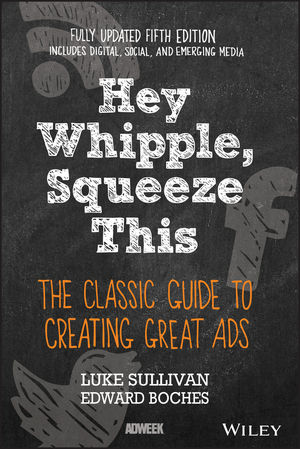Please Don’t Squeeze the Creativity
COM prof helps update classic advertising text for new media

COM’s Edward Boches contributed chapters about new media strategies to the fifth edition of Hey, Whipple, Squeeze This: The Classic Guide to Creating Great Ads.
Red Bull got a guy to jump out of a balloon 24 miles above the Earth, and millions streamed it on YouTube. Century 21 made a splash by listing fictional television drug kingpin Walter White’s house on Craigslist. And people all over the world dumped buckets of ice water on their heads to raise money for ALS research simply because they saw other Facebook users do it.
As these examples demonstrate, YouTube, Facebook, Twitter, Instagram, and the mobile web have transformed the advertising world. The best ads these days are often not ads at all in the traditional sense, says Edward Boches (COM’76), a College of Communication professor of the practice, advertising, and former chief creative officer at the top-tier Mullen ad agency, in Boston. The skydiver didn’t hold up a Red Bull when he landed, Century 21 didn’t buy an ad on the Breaking Bad finale, and the Ice Bucket Challenge depended on people wanting to imitate what they’d seen online.
Boches uses these and numerous other examples of this new kind of ad in the fifth edition of the creative advertising bible Hey, Whipple, Squeeze This: The Classic Guide to Creating Great Ads (John Wiley & Sons, Inc., 2016). Written by Luke Sullivan and first published in 1998, it’s considered one of the best advertising books of all time. The title is a reference (for those too young to remember) to one of the most ubiquitous, and lampooned, TV ads of yesteryear, where a shopkeeper named Mr. Whipple scolds customers for squeezing Charmin bathroom tissue, even though he cannot resist doing the same.
“The stuff that’s getting made is no longer print-centric or traditional TV- and video-centric,” he says. “They are concepts that are trans-media storytelling or are using mobile- or user-generated content.”
A COM professor since 2012, Boches still dresses the part of a successful “creative”: black wardrobe, long gray hair, stylish red glasses. He notes with a smile that his second floor COM office, with its view of the Center for Integrated Life Sciences & Engineering construction site, is a little less lavish than his former digs at Mullen. His best-known campaigns there included work for Google, Monster.com, Timberland, and General Motors. During his 30-plus years at the agency, Boches became known as one of the industry’s early adopters of new media like Twitter and a staunch advocate of the idea that a new way of doing things was necessary to keep up with the changing media landscape. One of his last coups for Mullen was creating the Brand Bowl for real-time social media measurement of response to Super Bowl ads. The last position he held at the agency was chief innovation officer.
 For the book’s new edition, Boches has joined Sullivan as a contributing writer, penning chapters focusing on very different kinds of ads in a landscape dominated by new media and social networks.
For the book’s new edition, Boches has joined Sullivan as a contributing writer, penning chapters focusing on very different kinds of ads in a landscape dominated by new media and social networks.
Hey, Whipple publisher, John Wiley & Sons, Inc., wanted Boches to write an advertising book of his own, he says, but “books are long, and I worked in advertising, where things are short. I had outlines and good intentions, and never really got around to it.”
He and Sullivan, a highly regarded copywriter for several top agencies, had known of each other for years. Boches had used Hey, Whipple in his COM classes, and he had given Sullivan permission to use some of his blog posts in the book’s fourth edition, published in 2012. They finally met a couple of years ago when Sullivan came to Boston to give a speech, and they hit it off immediately. Not long after, Sullivan asked Boches to punch in on the fifth edition.
“For starters, Edward is a great copywriter and ad person. Witness this week’s article from AdAge where they name his famous Monster.com commercial as the number 2 all-time Super Bowl spot,” Sullivan says. “Aside from being great at all the old-school crafts of copywriting and coming up with concepts, Edward was an early adopter and advocate of all things digital.”
Hey, Whipple is an often-irreverent how-to guide for making creative advertising that works and avoiding common pitfalls along the way. “It’s not a textbook,” Boches says. “It’s really for the industry, but it’s also for young creatives who are looking for ideas and insights and ways to think about tackling that blank page or screen.”
His main contributions to the new edition can be found in chapters 10 through 15, with titles like “Digital Isn’t a Medium, It’s a Way of Life” and “Why Pay for Attention When You Can Earn It?” His focus is on the new mind-set of the social media era and on creating nontraditional campaigns that go viral, often by involving the consumer. Hence Red Bull’s skydiver—which was a YouTube clip, not a paid ad—Century 21’s Breaking Bad Craigslist gag, and the viral spread of the Ice Bucket Challenge.
“I tried to cover what is digital, what is digital creativity, and what does that mean for experiential stuff or web-based stuff or mobile?” Boches says. “And I tried to do it in a way where you’re not just rattling off examples, but trying to dissect those examples so that you can extract some lessons.”
Adapting to rapidly developing digital and social media proved wrenching for the ad industry, he says, especially with the introduction of Facebook and Twitter: “It wasn’t that they were new media, but that there were very, very quickly new behaviors.”
Boches says too many of his contemporaries were stricken with “fear of being a rookie when you’re supposed to be an expert.” Boches, though, dived in with the help of a couple of young Mullen hires and quickly found himself on the speaker circuit. After Mullen, he worked for a start-up before getting a call inviting him to teach at COM.
“Whatever new media comes along, the industry takes whatever they have done someplace else and slams it in there,” he says with a trace of exasperation. They filled the web at first with static brochures when it was supposed to be interactive, he says, and now they’re taking banner ads made for computer screens and sticking them onto the bottom of cell phone screens. But that’s not what works, Boches says.
“When you think of mobile, it’s more about context and developing stories that fit within the platform,” he says. “How do I create useful, interesting stories in the vernacular of Snapchat that might only live for a day, using the right tone of voice and connecting very, very specifically with a person’s interest?”
He admits that he often uses ad blockers on his own iPhone. His contribution to Hey, Whipple may help the next generation of creatives keep others from doing the same.
“What both Luke and I believe is that there are constants that transcend all of the new technologies,” Boches says. Those include “the ability to narrowly and clearly identify a problem, develop a strategy for how to tackle it, and be able to generate a wealth of creative ideas to find what might be most effective.”

Comments & Discussion
Boston University moderates comments to facilitate an informed, substantive, civil conversation. Abusive, profane, self-promotional, misleading, incoherent or off-topic comments will be rejected. Moderators are staffed during regular business hours (EST) and can only accept comments written in English. Statistics or facts must include a citation or a link to the citation.